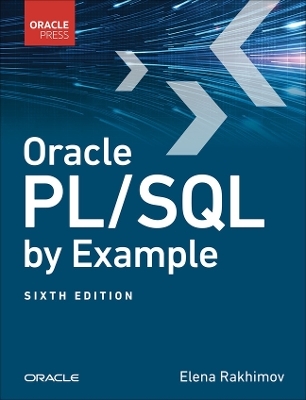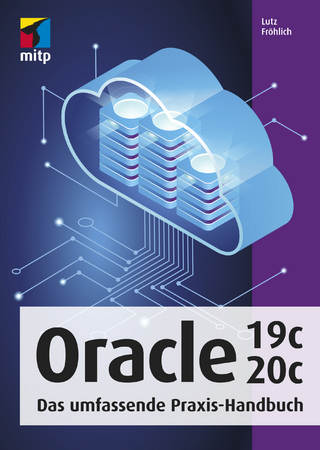
Study Guide for Oracle Certified Master 11G Exam
Apress (Verlag)
978-1-4842-0999-8 (ISBN)
- Keine Verlagsinformationen verfügbar
- Artikel merken
What's more, at the end of each chapter, he gives you specific hand-on tasks and challenges that must be solved within a specific amount of time. These tasks will not only help you gain the confidence you need to tackle the OCM exam, but also be sure-footed while handling critical issues at work. The book, filled with real-life scenarios and examples, will prove to be useful even for someone who does not intend to take the exam. Study Guide for Oracle Certified Master 11g Exam will ensure that you: * Are ready for every single OCM topic by guiding you with clear concepts and practical hands-on experience.* Will learn how to solve daily problems related to any part of Oracle Database Administration, since an OCM's scope is broad-even without benefit of a GUI (one of the exam's requirements). * Will learn how to install and configure RAC, ASM, GRID, and DataGuard, among others.* Know how to back up a database, tune it for optimal efficiency, and solve any kind of database failure.By earning an OCM certificate, you will become part of an elite group of Oracle professionals, significantly enhancing your job prospects!
I'm an Oracle ACE Director and Oracle Certified Master DBA with 7 years of experience managing UNIX-based Oracle Databases. As a working IT professional, I have experience in a wide range of mission critical technologies, specializing in database administration best practices for backup and recovery. I'm an author of the book -- "Oracle Backup & Recovery: Expert secrets for using RMAN and Data Pump", blogging at http://www.kamranagayev.com and frequent speaker at international conferences at USA, Japan, China, Thailand and Turkey. I'm also founder of Azerbaijan Oracle User Group (AzerOUG) Currently I'm pursuing a PhD in Computer Science at the Information Technology University and serve as an adjunct professor teaching Oracle Database Administration in a Qafqaz University.
TOC 1. Server Configuration Chapter Goal: In this chapter, brief information will be provided about how to create an OCM lab environment on the laptop. The reader also will know how to create a database and configure net parameters with and without GUI. This chapter goes to explain how to create different types of tablespaces; how to set up an NFS mount system; and the usage of OPatch, Grid Infrastructure, and EMCA 1.1. Create the database 1.2. Determine and set sizing parameters for database structures 1.3. Create and manage temporary, permanent, and undo tablespaces 1.4. Stripe data files across multiple physical devices and locations 1.5. Configure the database environment to support optimal data access performance 1.6. Create and manage database configuration files 1.7. Create and manage bigfile tablespaces 1.8. Create and manage a tablespace that uses NFS mounted file system file 1.9. Create and manage multiple network configuration files 1.10. Create and configure a listener 1.11. Configure the database instance to support shared server connections 1.12. Set up network tracing 1.13. Manage Oracle network processes 1.14. Configure the network environment to allow connections to multiple databases 1.15. Use configurationless connections 1.16. Use OPatch to install a patch 1.17. Use Grid Infrastructure to manage Oracle databases and other resources 1.18. Use the Enterprise Manager Configuration Assistant (EMCA) utility and Enterprise Manager Grid Control 2. Enterprise Manager Grid Control Chapter Goal: Installing, configuring and managing Oracle Enterprise Manager is a crucial job for every Oracle DBA. This chapter will shed light on how to install Oracle Grid Control, how to create jobs, alerts, notifications, schedules, windows, and programs. The chapter will also explain different ways to deploy an agent to different hosts. 2.1. Install and patch Enterprise Manager Grid Control software 2.2. Configure the Enterprise Manager repository 2.3. Create Enterprise Manager Grid Control users 2.4. Use Enterprise Manager to modify a database configuration 2.5. Configure Enterprise Manager to modify database availability 2.6. Create and manage jobs 2.7. Create and monitor alerts 2.8. Create notifications 2.9. Implement Grid Control and Database Control 2.10. Choose the appropriate tablespace type for the intended use 2.11. Create Scheduler jobs 2.12. Create schedules 2.13. Assign jobs to windows 2.14. Create programs 2.15. Create job classes 2.16. Install the Enterprise Manager Grid Control infrastructure 2.17. Deploy Enterprise Manager Grid Control agents 2.18. Configure Grid Control for business requirements 3. Managing Database Availability Chapter Goal: Backup and recovery are mission-critical DBA tasks, and it is critical that every Oracle professional develop a RMAN strategy that guarantees recoverability while minimizing unplanned downtime. RMAN is one of the world's most sophisticated backup and recovery tools. In this chapter, you will learn how to create a recovery catalog, how to perform a successful backup, how to configure RMAN and how to recover from almost any type of failure in Oracle. This chapter contains a lot of different recovery scenarios that will save your life either during OCM exam, or in a real-life production environment. 3.1. Maintain recovery catalogs 3.2. Configure Recovery Manager 3.3. Use Recovery Manager to perform database backups 3.4. Use Recover Manager to perform complete database restore and recovery operations 3.5. Configure RMAN 3.6. Create different types of RMAN backups to cater for different performance and retention requirements 3.7. Set Flashback Database parameters 3.8. Configure a Fast Recovery Area 3.9. Perform various recovery operations using Flashback technology 4. Managing Data Chapter Goal: During the OCM exam, the participant should be ready to move or to load any type of data using Data Pump and SQL*Loader. This chapter provides information on how to move the data using Data Pump either to local or over the network, how to use external tables and SQL*Loader. The reader will also get information on how to create different types of materialized views. 4.1. Manage Materialized Views to improve rewrite and refresh performance 4.2. Configure and manage distributed materialized views 4.3. Create and manage encrypted tablespaces 4.4. Manage transport of tablespaces across platforms 4.5. Configure a schema to support a star transformation query 4.6. Administer external tables 4.7. Implement Data Pump export and import jobs for data transfer 4.8. Implement Data Pump to and from remote databases 4.9. Configure and use parallel execution for queries 4.10. Use SQL*Loader 4.11. Administer, manage, and tune parallel execution 5. Data Warehouse Management Chapter Goal: In this chapter, reader will learn how to create different types of partitions, partition indexes, and LOBS. Detailed information will be provided on different ways to manage partitions and indexes. Also practical real-life scenarios will be shown related with fine-grained access control, context management, and flashback data archive. 5.1. Administer partitioned tables and indexes using appropriate methods and keys 5.2. Perform partition maintenance operations 5.3. Maintain indexes on a partitioned table 5.4. Implement securefile LOB 5.5. Create and manage LOB segments 5.6. Implement fine-grained access control 5.7. Create and manage contexts 5.8. Administer flashback data archive and schema evolution 6. Performance Management Chapter Goal: In this chapter, readers will learn how to use SQL Tuning Advisor and SQL Access Advisor, how to configure baseline templates, how to administer resource manager, and how to use use SQL plan management. 6.1. Administer Resource Manager 6.2. Use Result Cache 6.3. Use multi-column statistics 6.4. Gather statistics on a specific table without invalidating cursors 6.5. Use partitioned indexes 6.6. Administer and tune schema object to support various access methods 6.7. Interpret execution plan 6.8. Use SQL tuning tools and features 6.9. Use SQL Tuning Advisor 6.10. Use SQL Access Advisor 6.11. Use SQL Performance Analyzer 6.12. Configure baseline templates 6.13. Use SQL Plan Management feature 6.14. Implement instance caging 7. Grid Infrastructure and ASM Chapter Goal: In this chapter, step-by-step installation and configuration screenshots will be provided for the reader to successfully install and manage Oracle Grid Infrastructure, create and manage ASM instances, and ACFS file system. 7.1. Install Oracle Grid Infrastructure 7.2. Create ASM Disk Groups 7.3. Create and manage an ASM instance 7.4. Implement ASM failure groups 7.5. Creating ACFS File System 7.6. Start, stop, configure, and administer Oracle Grid Infrastructure 8. Real Application Clusters Chapter Goal: As in the previous chapter, very detailed, step-by-step installation screenshots for the installation of RAC on VirtualBox will be shown. After following all steps, the reader will successfully install and configure a 2-node RAC on a local laptop. 8.1. Install the Oracle Database 11gR2 software 8.2. Configure ASM for the shared disks and create a clustered database 8.3. Configure archiving 8.4. Configure services using both Manual and Policy Managed methods 9. Data Guard Chapter Goal: To provide a superior protection and availability, installing and configuring Data Guard is one of the main tasks of the DBA. In the last session of an OCM exam,test takers will be required to install and configure a standby database and perform switchover and failovers. The reader will get full details on configuring connect time failover, and converting standby to a snapshot standby in a few minutes. 9.1. Create physical standby database with real-time apply. 9.2. Configure the data guard environment to reduce overheads of fast incremental backups on the primary database 9.3. Configure the Observer 9.4. Switchover and switch back 9.5. Configure connect time failover 9.6. Convert the standby to a snapshot standby 9.7. Configure archivelog deletion policy for the Dataguard configuration
| Zusatzinfo | biography |
|---|---|
| Verlagsort | Berlin |
| Sprache | englisch |
| Maße | 178 x 254 mm |
| Themenwelt | Informatik ► Datenbanken ► Oracle |
| Schlagworte | Oracle 11g (Datenbank); Prüfungsvorbereitungen |
| ISBN-10 | 1-4842-0999-0 / 1484209990 |
| ISBN-13 | 978-1-4842-0999-8 / 9781484209998 |
| Zustand | Neuware |
| Haben Sie eine Frage zum Produkt? |
aus dem Bereich


